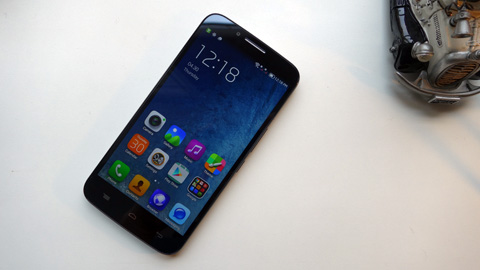
Alcatel has been somewhat quiet for a time now but the announcement of the Flash Plus has sparked a lot of interest from the public when we first revealed it back in March. Check out our full review of the Alcatel Flash Plus after the break.

For the purpose of this review, we managed to borrow a pre-release model of the Flash Plus. We were told it has not been updated with the latest firmware and it also runs on a different clock speed (8 x 1.7GHz vs. the retail unit which is 8 x 1.5GHz).
Design and Construction.
The One Touch Flash Plus follows the same old design signature of Alcatel from the likes of the Idol series. It’s simple, flat with rounded edges in a thin and sleek form factor.

The power button and volume rocker are on the right side along with the 2nd SIM card slot while the microSD and 1st SIM card slot are on the left side. The 3.5mm audio port is up top and the micro-USB charging port is at the bottom.
At the back side is the 13-megapixel rear camera with a small LED flash just below it thought the camera slightly protrudes from the base by about a millimeter. A large Alcatel OneTouch logo is smack right in the center while the speaker grills are lined up at the bottom end.

It has a non-removable back cover so you don’t have access to the 3,500mAh battery inside. The back panel has a matte, smooth finish in slate (somewhat ocean blue) color.
The front panel is all covered in glass with a metal frame around it. The capacitive soft keys at the bottom end are not backlit but painted in bright silver for better visibility.
With it’s large 5.5-inch display, the Flash Plus still feels good on the hands, light weight and provides good grip. The very smooth finish does make it a bit slippery on the hand sometimes.
Over-all, the design looks simple and unassuming.
Display and Multimedia.
The Flash Plus has a fairly large 5.5-inch IPS LCD display although the screen resolution is just 720×1280 pixels. While a pixel density of 268ppi might be decent and enough for most people, some would still look for a better resolution like a full HD screen.

Nevertheless, we found the 720p screen to be just about right. Plus, it comes with a few advantages — better battery life due to lower power requirement from the display and better performance (as seen in benchmark scores) due to fewer pixels being pushed by the GPU.

Alcatel Flash Plus beside the Asus Zenfone 2
The bezels on the sides are a bit thick, perhaps around 3mm with a screen-to-body ratio of 71.7%. The screen is clear and crisp but you can see the pixels upon closer inspection. The display lacks the needed brightness even if you crank up the settings to the highest level.
OS, Apps and UI.
Alcatel’s own UI looked simple and flat with no app drawer to speak of, just a bunch of folders to organize the apps by category. This implementation is similar to the Emotion UI of Huawei and OPPO’s Color OS. With a 64-bit octa-core processor and 2GB of RAM, the device feels very snappy and responsive.

The UI has built-in Smart Gestures which allows for Double Tap to Wakeup (no Double Tap to Sleep though) and custom gestures that allow you to draw on the screen (while it’s off) to launch features or apps (like a circle or letter O to open the camera).
The Night Mode allows you to turn the screen to a shade of either red, black or yellow and a Color Temperature slider to set the screen’s color temperature.
There is a built-in QR code reader and Cast screen which is basically just a Miracast feature.

The Smart Somatosensory settings offer a slew of nifty features like Smart Answer (answer calls by placing handset near the ear), Gallery swipe (slide to next photo by waving hand near the screen) is similar to O+ air gestures, same goes with the camera app (wave to take a shot),and a Call Answering Car (place the palm in front of the sensor for 2 seconds to auto-answer a call when connected to the Bluetooth speaker).
The Flash Plus runs on Android 4.4.4 Kitkat and we’re not sure if Alcatel has plans to update it to Lollipop any time soon.
Camera.
The Flash Plus camera is good and can be great at times as long as you have ample ambient light. It does not perform very well under low-light conditions though due to the small f2.2 aperture.

Here are sample photos we took using the rear camera:
We also noticed that a details are lost when shooting wide or panoramic scenes though stills looked much better in close up or macro shots.
Here are sample video clips:

The 8-megapixel front-facing camera performs just as well (although we already know that picture quality does not directly correlate with pixel size).
Performance and Benchmarks.
The Flash Plus uses a Mediatek MT6752 which is a 64-bit octa-core 4G LTE chip based on the ARM Cortex-A53 processor with ARM Mali-T760 graphics. It has a maximum core speed of 2.0GHz but in the case of the Flash Plus, they underclocked it to just 1.7GHz to allow for better battery efficiency.

Reviewer’s Note: The variant we used in this review runs on a 1.7GHz clock speed while the retail version will only be 1.5GHz. This will affect the benchmark scores and even slightly improve battery life.
The handset performed very well with resource intensive tasks and runs most of the apps and games very smoothly.

| Benchmark Test | Alcatel Flash Plus | Zenfone 2 ZE500CL |
| Antutu Benchmark | 43,519 | 23,231 |
| Quadrant Standard | 20,149 | 8,182 |
| Vellamo | 1,675 (Multicore)
| 938 (Multicore) |
| 3,238 (Chrome) | 1366 (Chrome) |
| 1,194 (Metal) | 646 (Metal) |
| PCMark | 4,030 (Work Performance) | 3,573 (Ice Storm Unlimited) |
| 3DMark | 6,752 (Ice Storm Extreme) | - |
With 2GB of RAM and 8 CPU cores, the Flash Plus managed the system pretty efficiently. It took over a dozen running apps to significantly affect multitasking performance.

The Antutu score of 43,519 is pretty impressive — it sits between the 1.8GHz Z3560 of the Zenfone 2 ZE550ML at 42k and the 2.3GHz Z3580 of the Zenfone 2 ZE551ML at 45k.
We did not notice any overheating problems when running resource intensive tasks while LTE connection is downloading heavy files in the background. The ARM Cortex A53 seemed stable and operated normally during these heavy tasks.
Battery Life.
With a power-efficient processor and large battery capacity of 3,500mAh, we were expecting the Flash Plus to excel in the battery life department. Indeed, the results of our tests showed impressive scores.

With our standard video loop test, the Alcatel Flash Plus managed to last 13.5 hours on a single full charge at 50% brightness and 0% volume. That’s perhaps one of the highest battery life we’ve ever seen and tested in the longest time, pretty close to the battery performance of the Mate 7.
Using PCMark Battery Test we managed to get about 10 hours and 23 minutes which is the highest we’ve seen so far in this test.
The unit comes with a basic Power Saver mode (Power+) that conserves battery life which adds about 4 hours more idle time (as measured by DU Battery at 90% full).
During normal or moderate use, the handset managed to last close to two days worth of use.
Call Quality and Connectivity.
The Alcatel UI handled dual SIM functionality well. We got to familiarize with how it works quickly and did not have issues with using two SIM cards at once.
Cellular signal was strong and we could connect to LTE networks fairly fast in all areas we regularly stay. Voice calls are clear, text messages are sent and received almost immediately and we did not encounter any problems in the past couple of weeks using the handset.

Using Mediatek’s MT6752M chip, the Flash Plus is able to support dual-SIM with dual-LTE functionality. This means both LTE SIM slots can connect to LTE networks of both Smart and Globe. However, LTE activity is only enabled one at a time.
Aside from LTE, the handset also supports WiFi 802.11n, Bluetooth 4.0, and Miracast.
Conclusion.
It’s no doubt Alcatel has a huge winner here with the Flash Plus. From the very moment we broke the news back in March, we were confident it would sell well based on the estimated price we bounced around.
It’s not a perfect handset but it’s probably one of the best ones out there that you can get for under Php7,000. Local brands would be hard pressed to pit their flagship devices with this one.

Lazada will be selling the Flash Plus exclusively starting May 15 at 12:00 noon with a suggested retail price of Php6,490 for the 16GB slate color variant (see listing report here).
Alcatel OneTouch Flash Plus specs:
5.5-inch IPS LCD @ 720×1280 pixels, 268ppi
Dragontrail Glass, Japan OGS full lamination
Mediatek MT6752M 1.5GHz octa-core processor, Cortex-A53
Mali T760 MP2 GPU
2GB RAM
16GB internal storage
up to 32GB via microSD
USB OTG support
Dual-SIM, Dual-LTE, FDD/TD-LTE
13MP rear camera with LED flash, f2.2
8MP front-facing camera, f2.2
WiFi 802.11 b/g/n
Miracast
Bluetooth 4.0
FM radio
GPS with aGPS support
Li-Ion 3,500mAh battery
Android 4.4.4 Kitkat
152.3 x 76.4 x 8mm (dimensions)
147 grams (weight)
What we liked about it:
- Great performance
- Dual-LTE capability
- Impressive battery life
- Very affordable price
What we did not like:
- Non-removable battery
- UI needs some refinements
The post Alcatel Flash Plus Review appeared first on YugaTech | Philippines, Tech News & Reviews.






























